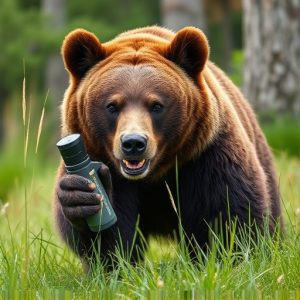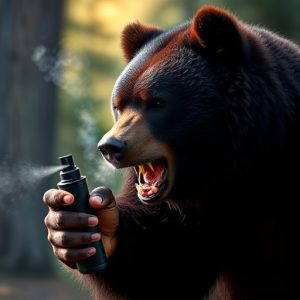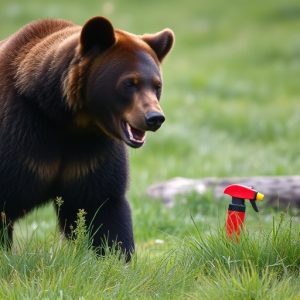Mastering Bear Spray Range: Safety Tips for Optimal Wind Conditions
Understanding the 30-foot range of bear spray is crucial for safety in bear-infested areas, with win…….
Understanding the 30-foot range of bear spray is crucial for safety in bear-infested areas, with wind direction playing a significant role. Factors like wind speed and angle, humidity, and temperature can impact spray reach. Optimal conditions include light to moderate breezes (5-15 mph) and direct spraying into the wind towards a bear's face. Anticipating wind patterns and practicing safe deployment techniques, including maintaining distance, staying calm, and using noise, are essential tips for outdoor enthusiasts navigating bear country. Bear spray should be used alongside knowledge of bear behavior and prevention methods for safe interactions with these wild animals.
“Uncovering the Mystery of Bear Spray’s 30-Foot Range: Your Ultimate Guide to Safety in Wilderness Encounters. Bear spray, a powerful tool for self-defense against bears, boasts an impressive 30-foot effective range. But what does this truly mean? This article delves into the science behind bear spray range, exploring factors like wind direction and spray patterns. We provide essential safety tips for responsible usage and emphasize the importance of training to ensure effectiveness in real-life situations. Stay prepared with these key insights regarding bear spray wind direction safety tips.”
- Understanding Bear Spray Range: What Does 'Thirty Feet' Mean?
- Factors Affecting Bear Spray Effective Range
- Optimal Wind Conditions for Maximum Effectiveness
- Safety Tips When Using Bear Spray in the Wild
- Training and Practice: Ensuring You're Prepared for Real-Life Scenarios
Understanding Bear Spray Range: What Does 'Thirty Feet' Mean?
Understanding Bear Spray Range: What Does ‘Thirty Feet’ Mean?
When considering bear spray, it’s essential to grasp the concept of its effective range. The thirty-foot range is a crucial safety tip that provides users with a vital window of protection. This distance isn’t merely a measurement; it’s the optimal proximity to ensure the spray reaches the bear effectively. Factors like wind direction play a significant role in how far the spray will travel, making it imperative for users to be mindful of their surroundings.
Knowing this range allows outdoor enthusiasts and individuals living in bear-infested areas to make informed decisions about their safety. By understanding where the spray is most effective, users can strategically position themselves and minimize risks during encounters with bears. Bear spray wind direction safety tips further enhance one’s ability to protect themselves, ensuring that the spray reaches the bear while maintaining a safe distance for the user.
Factors Affecting Bear Spray Effective Range
The effective range of bear spray is typically around thirty feet, but several factors can influence this distance. One of the key considerations is the wind direction—a headwind can extend the reach of the spray, while a tailwind might reduce it. Understanding wind patterns in the wilderness is essential for optimal safety tips when carrying bear spray.
Another factor is the angle at which the spray is directed. Aiming directly at the bear’s face will increase the likelihood of effective deterrence within the stated range. Additionally, environmental conditions such as humidity and temperature can impact how far the spray travels, with moist air sometimes carrying the spray further than dry air. Knowing these variables enables users to make informed decisions while navigating in bear country.
Optimal Wind Conditions for Maximum Effectiveness
Optimal wind conditions play a significant role in maximizing the effectiveness of bear spray, an essential tool for safety when encountering bears in their natural habitat. When using bear spray, it’s crucial to consider not only the proximity of the bear but also the direction and strength of the wind. A light to moderate breeze (around 5-15 mph) is ideal as it aids in distributing the spray evenly over a wider area, ensuring better coverage and greater safety.
Understanding wind direction is vital for effective usage. Spraying towards the wind allows the irritants to reach the bear’s face directly, causing it to retreat promptly. Conversely, spraying into an updraft or downwind might result in the spray blowing back onto the user, reducing its effectiveness. Therefore, knowing and anticipating wind conditions before approaching bears can significantly enhance safety tips for outdoor enthusiasts and individuals living in bear country.
Safety Tips When Using Bear Spray in the Wild
When using bear spray, understanding the wind direction is crucial for maximum effectiveness and safety. Always assess the weather conditions before deploying the spray; an ideal scenario is when there’s no wind or minimal crosswinds, allowing the spray to reach its 30-foot range accurately. If possible, face the spray towards the bear while maintaining a safe distance. Keep in mind that the wind can alter the spray’s trajectory, potentially causing it to blow back onto you if not used properly.
Additional safety tips include keeping your bearings and remaining calm during an encounter. Practice good hygiene by cleaning gear regularly to avoid attracting bears with food residue. Always travel in groups whenever possible, making loud noises to signal your presence and deter potential aggression. Bear spray is a valuable tool for self-defense but should be used as a last resort; knowledge of bear behavior and prevention techniques are equally important for ensuring safe interactions in the wild.
Training and Practice: Ensuring You're Prepared for Real-Life Scenarios
Proper training and practice are essential when it comes to using bear spray, as it can mean the difference between a safe encounter and a potentially dangerous one. Learning the correct technique and understanding the effective range (typically around 30 feet) is crucial. Practice sessions should simulate real-life scenarios, taking into account variables like wind direction. Safety tips include ensuring you have line of sight to the bear and knowing how to properly deploy the spray. Regular training keeps individuals prepared and confident when facing an actual bear encounter, allowing them to react quickly and effectively.
Understanding the wind direction is a game-changer in bear spray effectiveness. It’s best to practice and train with professionals who can guide you on how to account for wind speed and direction during use. Bear spray isn’t just about spraying; it’s about using it strategically. With proper training, individuals can enhance their safety tips and ensure they’re prepared to navigate through any unexpected encounters in the wild, where bear presence is common.
Bear spray is a powerful tool for self-defense against aggressive bears, but understanding its effective range and optimal usage conditions is crucial. With a range of thirty feet, knowing the wind direction becomes essential for maximizing its effectiveness. By practicing safety tips and regularly training in real-life scenarios, individuals can ensure they’re prepared to handle bear encounters confidently and safely. Remember, proper preparation and knowledge are key to navigating the outdoors with peace of mind.


